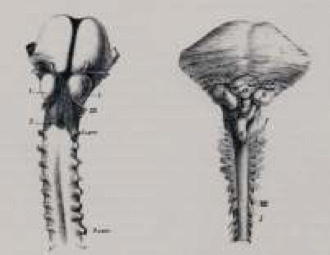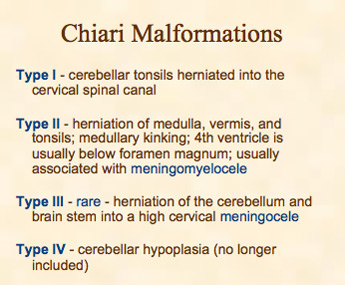
Figure 4
And this is a happy situation with the brain stem turning into the spinal cord, the cerebellum. It helps us to look from behind to see that there are two tonsils. [see Figure 4] This is the cerebellum and the protrusions at the bottom of the cerebellum are called tonsils, different from the tonsils at the back of our throat, of course. They hang down to the foramen. Here’s the spinal cord, these are the vertebral arteries that supply the brain, two of them that supply the brain, here’s an important branch of this vertebral artery called posterior inferior cerebellar artery or PICA for short, that supplies the brain stem itself and obviously is a very critical blood vessel. Just a little bit on spinal cord anatomy. [see Figure 5] Spinal cord is a complex highway track. There are highways running up and down and the big highways, in particular, the lateral cortical spinal track, this is heading down and helping you move your arms and legs. It’s of interest that the fibers coming out of the neck are closer to the center of the cord. These are feeling fibers. Also of interest that the cervical is more central than the sacral, this is thoracic, lumbar, sacral. And some other, but the bottom line is that when we’re going to talk syringomyelia it’s going to occur here centrally and it may start impacting some of these fibers earlier than the later fibers. A little bit of anatomy, but it’s also important to recognize the history.

Figure 5

Figure 6
It was Charles Prosper Ollivier d’Angers, a French pathologist, who in 1827 wrote this treaty on the spinal cord and its illnesses here in French and this is where he created the term syringomyelia. He had found a cavity within the spinal cord of some of his dissections and he created this name from Greek. Syrinx, meaning a pipe or tube or channel and myelus, the word for marrows. So a syrinx in the marrow, or syringomyelia is where we get the first name for syringomyelia. And then of course, Dr. Chiari, somewhat later in that century, wrote two very important papers. He’s the professor at the University of Prague, a pathologist. He wrote a paper concerning the changes in the cerebellum due to hydrocephalus of the cerebrum. And it is in this paper he described three types of brain stem anomaly of the hindbrain and gave a case for each. But he kept working and a few years later reported on another 24 cases and this is the first report showing that syringomyelia could occur in people with Chiari malformations, so it’s the first association now of those two conditions. And so what are the types to review? [see Figure 6] Initially he described 4, at least by a second paper he described 4.

